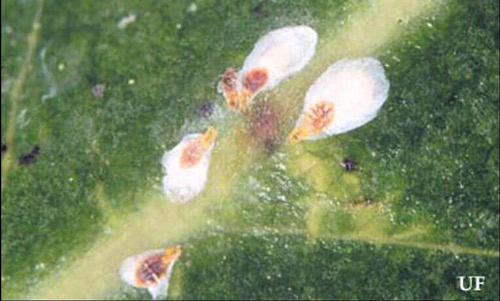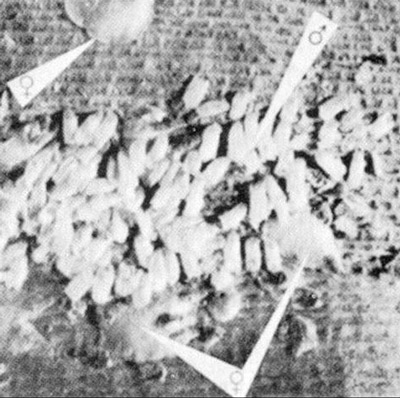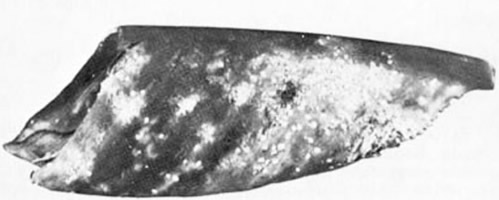common name: false oleander scale
scientific name: Pseudaulacaspis cockerelli (Cooley) (Insecta: Hemiptera: Coccoidea:
Diaspididae)
Introduction - Description - Economic Importance - Hosts - Survey and Detection - Management - Selected References
Introduction (Back to Top)
False oleander scale, an armored scale, was first described in California from palms taken in quarantine from China. It was first found in Florida at Meade Gardens, Winter Park, Orange County, by J. R. Springer on sweetbay (Magnolia virginiana L.) in 1942. In 1953, G. B. Merrill reported the distribution in Florida as Orange and Leon counties. It is now widespread in Florida, Georgia and Alabama, and probably occurs in all of the Gulf States.
This scale formerly was referred to as magnolia white scale (Phenacaspis natalensis Ckll.) and oleander scale (Phenacaspis cockerelli (Cooley)).
Description (Back to Top)
The female armor is pear-shaped, glossy white, and 2 to 3 mm long. The exuviae are terminal and yellowish brown. The size of the female scale may vary with the host. For example, it is slightly smaller on palmetto than on aucuba. The male armor is elongate, snow-white, feebly tricarinate, and about 1 mm long. The male exuviae are terminal with a faint yellowish tinge. Males usually occur in clusters on the leaf.
Figure 1. False oleander scale, Pseudaulacaspis cockerelli (Cooley).
Figure 2. Female false oleander scales, Pseudaulacaspis cockerelli (Cooley). Photograph by University of Florida.
Figure 3. Cluster of male false oleander scales, Pseudaulacaspis cockerelli (Cooley), on leaf of bird-of-paradise. A few female scales are present. Photograph by Division of Plant Industry.
Economic Importance (Back to Top)
False oleander scale has become an economic pest of many of the major ornamental plants found in Florida commercial nurseries. The rapid distribution throughout Florida can be attributed to the movement of infested nursery stock.
The scale tends to confine itself to feeding on foliage and rarely attacks tender shoots or fruit. Its feeding causes chlorotic spots that are visible on the upper leaf surface. These spots are usually several times larger than the scale. Heavy infestations cause the entire leaf to turn yellow and drop prematurely.
Figure 4. False oleander scales, Pseudaulacaspis cockerelli (Cooley), on leaf of bird-of-paradise. Photograph by Division of Plant Industry.
Hosts (Back to Top)
False oleander scale is probably not a good name as this species has over 100 plant species recorded as hosts in Florida (Dekle 1976). These include: Magonolia grandiflora, magnolia; M. virginiana, sweetbay; Aucuba japonica; Strelitzia spp, bird-of-paradise; Hedera helix; Cornus florida, flowering dogwood; Taxus spp.; Nerium oleander, oleander; Michelia figo, banana shrub; Elaesgnus spp.; and Sabal mexicana, a palmetto (Merrill 1953, Johnson 1991). This scale is also an important pest of Mangifera indica, mango (Crane 2006).
Survey and Detection (Back to Top)
- All life stages of the scale may be found throughout the year.
- Visually inspect both leaf surfaces.
- If necessary for identification, submit adult female specimens attached to the host plant in a plastic bag or envelope to either DPI or your local county Cooperative Extension Service office.
Management (Back to Top)
Scales, especially armored scales are very difficult to control when mature. Examine plants for
live scales by crushing the wax cover. Dead scales do not fall from plants. Select pesticides
that have the least effect upon other non-target organisms. For established infestations, apply a
second application in two weeks. Horticultural oils are often effective and relatively safe on
beneficial organisms. Time sprays to coincide with the crawler stage which is most susceptible
to insecticides.
Florida Insect Management Guide for mango
Selected References (Back to Top)
- Crane JH, Balerdi CF, Maguire I. (November 2006). Mango growing in the Florida home landscape. EDIS. http://edis.ifas.ufl.edu/MG216.
- Dekle GW. 1976. Florida Armored Scale Insects. Florida Department of Agricultural and Consumer Services, Division of Plant Industry. Arthropods of Florida and neighboring land areas 3: 1-345.
- Merrill GB. 1953. A Revision of the Scale Insects of Florida. Plant Board of Florida. Bulletin 1: 1-143.
- Johnson WT, Lyon HH. 1991. Insects That Feed on Trees and Shrubs. 2nd edition, revised. Comstock Publishing Associates. 560 pp.



